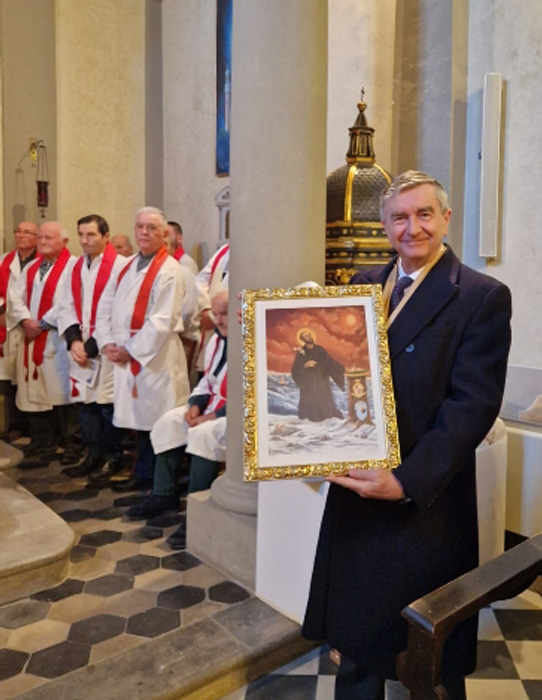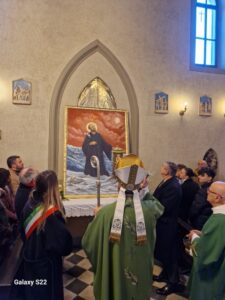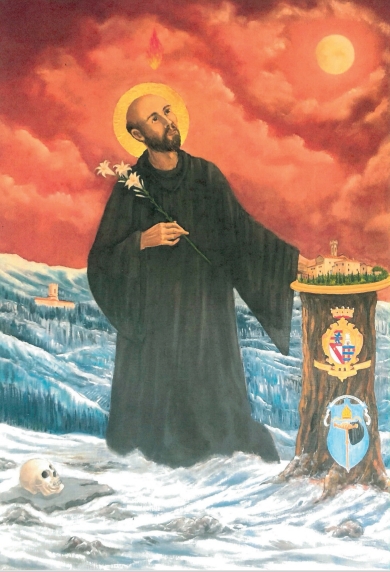
Blessed Benedetto Ricasoli: the feudal lord who became a hermit
22 March, 2024

A few weeks ago, Francesco Ricasoli was in the church of Santa Maria a Ricasoli, in the small hamlet of Montevarchi, in the province of Arezzo, for the unveiling of a work by the Master painter, Francesco Tonini, dedicated to an ancestor who definitely occupies a prominent place in the history of the Ricasoli family. Unlike many of the figures included in the family’s famous family tree, dated 1584, he was not a warrior but a man of prayer. We are speaking of Benno, known as Bennone, a name of Lombard origin, later Italianized into Benedetto Ricasoli, who lived even before that 1141 date to which the first records of the Ricasoli family and its wine production in Brolio can be traced. Benno was, in fact, born in 1040 and died at Badia a Coltibuono in the commune of Gaiole on January 20, 1107; eight centuries later, in 1907, he was beatified by Pope Pius X.
Benedetto lived in this area of Chianti, as attested by many accounts collected in an excellent paper by historian Fulvio Bernacchioni. He spent his youth among the many castles his family owned, scattered between Chianti and Valdarno. In the mid-11th century, along with his brothers, he contributed to the founding of the Vallombrosian monastic movement at Coltibuono through donations of land to the abbot and his monks. From then on, however, about twenty more years passed before his life underwent a radical change. That is, when Benno, a powerful and respected feudal lord, decided in 1093, to abandon his life of privilege and go to live in the very monastery of Coltibuono that he had helped to bring into being and grow during the turbulent era, fraught with danger, that was the early Middle Ages. However, after a short time, life in the monastery no longer seemed enough for him, and so, with the abbot’s permission, he retired to a hermit life in a dense forest not far from the monastery. There, he built himself a makeshift cell out of tree trunks and would never leave it again, apart from when he observed the principal solemnities of the year.
Benno’s earthly adventure came to an end on a cold winter’s evening when, according to the monastic chronicles, the bells of the Abbey at Coltibuono began to ring on their own, the first in a series of unexplained events around Benno, which were deemed “miraculous.” The monks interpreted this circumstance as a sign from Benno and hurried towards his cell. When they arrived, they found him already dead, but still kneeling in the act of prayer and with his eyes turned to heaven, while a flame shone in the air above his hut. Because of the heavy snowfall, the monks thought that transporting the body would be impossible, but the snow melted as they passed by. Later, when they decided to move the body from the cloister of the Abbey at Coltibuono to lay it in a more suitable resting place, “when they opened the tomb, they were in great awe to find that there was a fresh, fragrant lily emerging from his mouth.” All these events are depicted in a beautiful 18th-century altar frontal still preserved in the Badia a Coltibuono church.
The memory of Blessed Benedetto Ricasoli is still very much alive in the area, as Tonini’s new painting testifies. The altarpiece depicts him on his knees, with his left arm outstretched towards a plate on which the village of Ricasoli lies. Copies of the painting are kept in the church of Madonna in Brolio and in the beautiful family chapel within the castle walls, which reopened for Tours on March 15. Please contact us for reservations.







